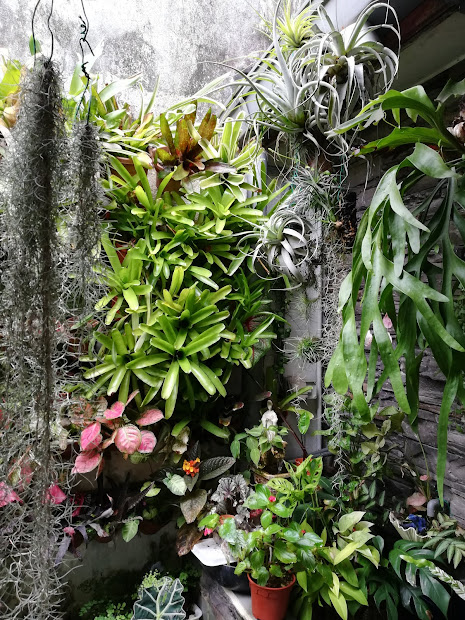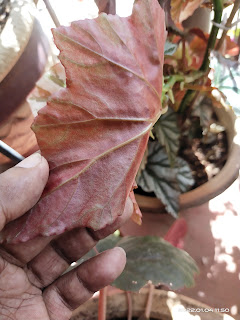Do click below for more information on Cane Begonias.Cane Begonia Care & Cultivation information.
Welcome to my Tropical Garden in Malaysia where the focus is mainly cultivating unique and colorful plants ranging from rare to common plants all around the tropical belt across the world.
Search This Blog
My Vertical Garden Wall

TRASLATION LANGUAGE (CLICK HERE)
Monday, November 21, 2022
Cane Begonia 'Frosty' / Cane Begonia 'Don Miller'
Do click below for more information on Cane Begonias.Cane Begonia Care & Cultivation information.
Friday, November 18, 2022
Cane Begonia "Looking Glass"
Do click below for more information on Cane Begonias.Cane Begonia Care & Cultivation information.
Cane Begonia 'White Ice'
Do click below for more information on Cane Begonias.
Cane Begonia Care & Cultivation information.
Wednesday, November 16, 2022
Cane Begonia - 'Pink Rubra' - Part 1
I must say that this particular one falls into a hardy category of Cane Begonia, also the ID seems to be a little misleading - I can only guess that this could be an identified cultivar which may have been cultivated throughout the years without any names attached to it - or simply put, it can just be identified as a Pink Flowered Cane Begonia.
However, these spotted Cane Begonia appears to be more subtle with speckles with fading dots when exposed to bright sunlight - the dots are more visible when placed in more shaded environment.
The Leaves appears to Fully Green in Full Sun and the plus point is that these will start blooming in that condition - the Key Identification of this particular Cane Begonia is this one has pinkish inflorescent.
Basic Plant Care as similar like most Cane Begonias - this one can be considered a hardy type.
Other matters are very much similar with the general information about Cane Begonias.
Do click below for more information on Cane Begonias.
Cane Begonia Care & Cultivation information.
Sunday, November 6, 2022
Cane Begonia Maculata Albopicta - Pink Inflorescence Blooms
Do check on more detailed information concerning this type of Begonia:
Introduction to Rare Plants Category - Cane Begonia Maculata Albopicta (Updated Nov 2022)
DIFFERENT TYPES OF CANE BEGONIAS
Other matters are very much similar with the general information about Cane Begonias.
Do click below for more information on Cane Begonias.
Cane Begonia Care & Cultivation information.
Introduction to Rare Plants Category - Cane Begonia Maculata Albopicta (Updated Nov 2022)
This growing condition style is called "Standard Form" as such identified as 'Tamaya'.
And such - You can actually groom the 'Tamaya' style to any Cane Begonias that have that bamboo like features - especially the Albo picta species, Lucerna species and the ones that appears to be hardy.
There are so many different types that works - choose one that works best in your garden condition.
- 30% coconut husk chips - aids stronger root growth
DIFFERENT TYPES OF CANE BEGONIAS
Other matters are very much similar with the general information about Cane Begonias.
Do click below for more information on Cane Begonias.
Cane Begonia Care & Cultivation information.
About Me

- James David
- Tropical Garden, Batu Caves, Malaysia
- My Malaysian Tropical Garden mainly focused on unique and colorful plants ranging from rare to common plants all around the tropical belt across the world. Ideal for inspiration for challenging areas in the garden space - indoor gardening, balcony gardening and small green spaces especially for ariods, bromeliads, begonias, edibles, cascading & vertical garden plants, succulents & cacti, orchids, together with both shade and sun loving plants.
Contact Me on the Form Above
Contact Form
Blog Archive
Favorite Popular Posts (Please click on links below)
- ANTHURIUM - Different Types with Names & Images
- JEWEL ALOCASIA - Different Types with Names & Images
- ALOCASIA - Different Types with Names & Images
- COLOCASIA (TARO) - Different Types with Names & Images
- BEGONIA - Different Types with Names & Images
- CANE BEGONIA - Different Types & Images
- DIEFFENBACHIA (DUMBCANE) - Different Types with Names & Images
- EPISCIA - Different Types & Images
- FERNS & ALLIES - Different Types (Names & Images)
- HUPERZIA (Tassel Ferns) Different Types - Name & Images
- DISCHIDIA - Different Types with Names & Images
- HOYA - Different Types with Names & Images
- CALLISIA - Different Types & Images
- TRADESCANTIA - Different Types with Names & Images
- INDOOR PLANTS - Different Types & Images
- FRAGRANT FLOWERS - Different Types of Tropical Fragrant Flowering Plants
- KVPA Plant Acquisition #PAE Events List
Popular Posts
-
My Garden is slowly settling to its permanent position where I'm going to maintain what I have currently. The best idea in keepi...
-
I had wanted to list all the begonias and their ID with images here. Somehow it will be overwhelming to put the whole genes here which ...
-
Most of my friends asked me about where I purchase my plants. I often tell them about this very famous nurseries, the ones located in Sg....
-
CANE BEGONIA UPDATE : 9th July 2024 I have found after years of experience that there are difference between Cane Begonia species where ther...
-
INTRODUCTION: To have or not to have. What if all the neighbors around your surrounding area plants this same plant, Would you consider ...
-
I would like to introduce a New Series on Indoor Plants and hope to come up with 10 Best Indoor Plants for Beginners. I'm guessing...
-
I had wanted to list all the Episcia and their ID with images here. Somehow it will be overwhelming to put the whole genes here which will ...
-
It was one of my zealous moments where I have decided to just go and see whats happening in this Orchid Garden. Its situated inside KL Lak...
-
I have come across many gardeners who had stopped gardening for the fear of mosquito's. Though it sound like a laughing matter but not s...
-
This is my collection of Dieffenbachia (Dumbcane) which I had managed to cultivate and grow. Strangely as it may seemed - I find some of the...
Popular Post - 1 Month
-
CANE BEGONIA UPDATE : 9th July 2024 I have found after years of experience that there are difference between Cane Begonia species where ther...
-
I had wanted to list all the begonias and their ID with images here. Somehow it will be overwhelming to put the whole genes here which ...
-
INTRODUCTION: To have or not to have. What if all the neighbors around your surrounding area plants this same plant, Would you consider ...
-
It feels like ages when I actually started this plant from seed to this point when I can finally enjoy the flower. I never imagine the mom...
-
INTRODUCTION: This un-named begonia listed as Begonia U497 was first found and identified in Thailand, supposedly sold in a plant market in ...
-
I had wanted to list all the Episcia and their ID with images here. Somehow it will be overwhelming to put the whole genes here which will ...
-
My Garden is slowly settling to its permanent position where I'm going to maintain what I have currently. The best idea in keepi...
-
Characteristics: This particular one has a heart shaped leaf formation and a vibrant dark purple coloration on it's foliage. Th...
-
What a Long Break : June 2023 - July 2024 From Blogging I'm so surprised that time just few just like that. A lot had happened during th...
-
Most of my friends asked me about where I purchase my plants. I often tell them about this very famous nurseries, the ones located in Sg....







































































